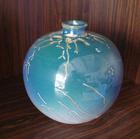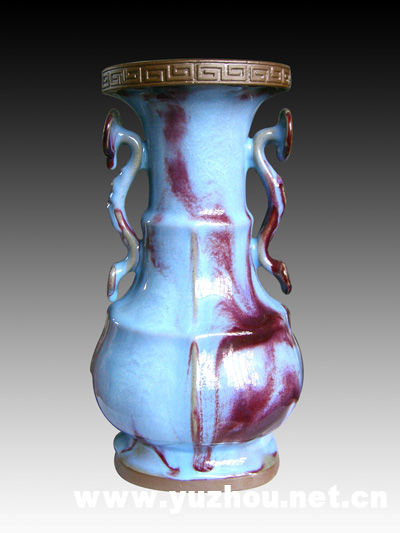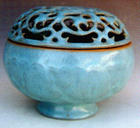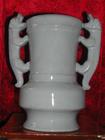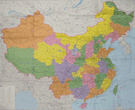Jun Porcelain
The Jun Porcelain, one of the five famous pieces of porcelain of
Song Dynasty (960-1279), was born in Yuzhou, Henan Province. As
the forefather' comment goes, the Jun Porcelain is known for its
bright color, splendid look, exquisite shape and clear sound
when being tapped. Emperors of different feudal dynasties took
it as a rare treasure and ordered utensils made of Jun Porcelain
for exclusive royal use. Thus, very few pieces of Jun Porcelain
circulated among the common people, and their price soared as
time went by.
|
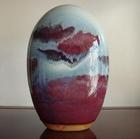
Jun Porcelain |
The key to the Jun Porcelain rarity lies in one porcelain in
porcelain-making, which is called "change in the kiln". Inside
the original frit for the porcelain, the craftsman has already
added the correct amount of copper. When the pieces are places
into the kiln, the inside temperature then is carefully varied
in the process, which results in the different patterns and
shapes of colors on the porcelain surface. As the "change in the
kiln" is not solely determined by human will, the creation of a
rare Jun Porcelain is a gift by luck. The wonderful patterns and
colors of the porcelain are born natural, beyond the control of
the craftsman, however skilful he is.
Ru Porcelain
The Ru Porcelain is also among the list of the five famous types
of porcelain from the Song Dynasty. Its birthplace is Ruzhou, a
city near Yuzhou. The Ru Porcelain appears smooth and glistening
as if it has just been taken out of water. Three main features
of the Ru Porcelain are the "pear peel", referring to the tiny
spots scattered under glaze, the "crab paw", meaning the
web-like texture on the glaze, and the "sesame flower", the
shape of the cracks in the glaze. Color of the Ru Porcelain
include pinkish green, greyish blue and tawny, and their under
glaze patterns and birds. Both pseudo classic ones and modern
necessities can be found among today's Ru Porcelain.
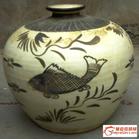
Ru
Porcelain
Tangshan Porcelain
Tangshan Porcelain of Hebei Province is a new
porcelain-producing city. The Tangshan Porcelain includes
porcelain for daily use, industrial porcelain, artistic
porcelain and large-scale porcelain engraving. The most precious
among the porcelain for civil use are the cinder porcelain, the
white-jade porcelain and the magnolia porcelain. The white-jade
porcelain is hard porcelain baked under high temperature. The
main material for the cinder porcelain is the cinder of animals
and that for the magnolia porcelain is talcum. The latter two
tapes of porcelain, smooth, fine grained and semi-transparent,
are famous throughout the world.
The best representative of the artistic porcelain is the
oxide-red, gold-ring crystallized glaze ware. Such porcelain is
able to change color in accordance with different light and
angle. As its creation process is extremely complicated, such
porcelain has a high artistic value.
Yixing Buccaro
Yixing in Jiangsu Province can produce various kinds of
porcelain, including vintage pottery. The vintage pottery, known
as the buckaroo, has won gold medals at international
exhibitions in Paris, Panama and Chicago.
Endowed with superb local earth and outstanding craftsmen,
Yixing is able to make many exquisite products. Its buckaroo tea
ware is especially prominent,
featured with a great variety and an elegant shape. There are
pseudo classic teapots in the shape of pumpkins, lotus-leafs and
lotus-roots. The buccaro wares can preserve the original flavor of the tea and prevent its deterioration. The longer
they are used, the better.
Longquan Celadon
The celadon produced in Longquan, Zhejiang Province, is the
first colourful porcelain of China. The kilns in Longquan
started in the 10th century and came into prominence in the
Southern Song Dynasty (1127-1279).
Longquan celadon looks plain and brawny, and its glaze bears a
bright and simple color. In the porcelain of Linglong (Delicate)
Celadon, various techniques, such as relief and hollowing-out
are combined to achieve transparent, semi-transparent, and
opaque effects. Longquan celadon can be classified as celadon
for daily using celadon, pseudo classic celadon and artistic
celadon. It is usually listed at high price, due to its small
production and complicated process.
White and Black Porcelain
Both the white porcelain of Dehua and the black porcelain of
Jianyang are famous porcelain produced in Fujian Province. The
town of Dehua in south Fujian started making semi-porcelain
wares as early as the Tang Dynasty (618-907), and its porcelain
products were shipped to Southeast Asian countries in the Song
Dynasty via the port of Quanzhou. In the Ming Dynasty
(1368-1644), the white porcelain production began. The black
porcelain produced in Jianyang, north Fujian, won favour with
the emperors from The Song Dynasty.
|
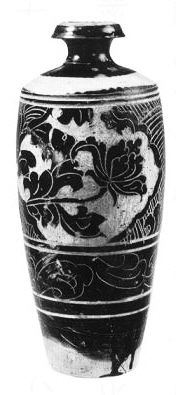
White and Black Porcelain |
The white porcelain can be divided into ivory white and snow
white. The white porcelain figure of Goddess of Mercy best
illustrates its value. Other products like tea and kitchen wares
also deserve a place in a well-furnished house. The smooth
surface of the black porcelain can provide mirror images. Rabbit
hair-like lines can clearly see under the glaze. The main
products are Rabbit Hair Cups, vases, stationery, tea set and
animal figures.
Zibo Artistic Porcelain
The artistic porcelain produced in Zibo enjoys high fame in
north China. They come in a great variety, including vivid
figure porcelain, eye-catching colourful pottery, and pseudo
classical porcelain. They are unique in the color of the glaze.
The "eyes of heaven" is a kind of glaze in a black background
strewn with silver dots. Wares of such glaze are very precious,
known as the top tea wares in Japan. The "Tea Litter Glaze" is
yellow and green-mottled. It is usually used in stationery, jugs
and jar-making. Such wares have a simple and ancient taste,
favoured by many collectors.
Yaozhou Celadon
Tongchuan, Shaanxi Province, was once the dependency of Yaozhou
years ago. Ancient kiln ruins can still be found lying in its
suburbs. In the Song Dynasty, the Yaozhou celadon was very
popular. Unfortunately, its techniques failed to be handed down
through the generations. However, about two decades ago, the
local porcelain factory succeeded in reviving the old
techniques. The glaze of Yaozhou Celadon is oval, with ice-like
texture. The products include incense burners, table wares, tea
sets, wine vessels and stationery.
Shiwan Porcelain
Shiwan Porcelain of Foshan, Guangdong Province, is no stranger
to tourists from Hong Kong, Macao and Southeast Asian countries
The pottery became famous in Qing Dynasty (1644-1911). Most
Shiwan Porcelain products are human figures. A visit to the
Foshan Ancestral Temple will leave you a deep impression of the
porcelain figures on eaves, roofs, and walls. Shiwan Porcelain
falls into four categories: The little pottery figures, animals,
and pavilions in a bonsai may be as small as a pea or a grain of
rice.
Fengxi Porcelain
Fengxi Town of Chaozhou is the main porcelain-producing area in
Guangdong Province. Although it bears a modern and foreign aura,
Fengxi started celadon productions as early as the Tang Dynasty.
In the Song Dynasty, it was able to make all-engraved porcelain.
The Fengxi Porcelain products mainly feature figures, flowers
and hollowed-out wares, serving both aesthetic and function
porposes. Fengxi also produces tea sets used for Chaozhou Kongku
Tea.
|






